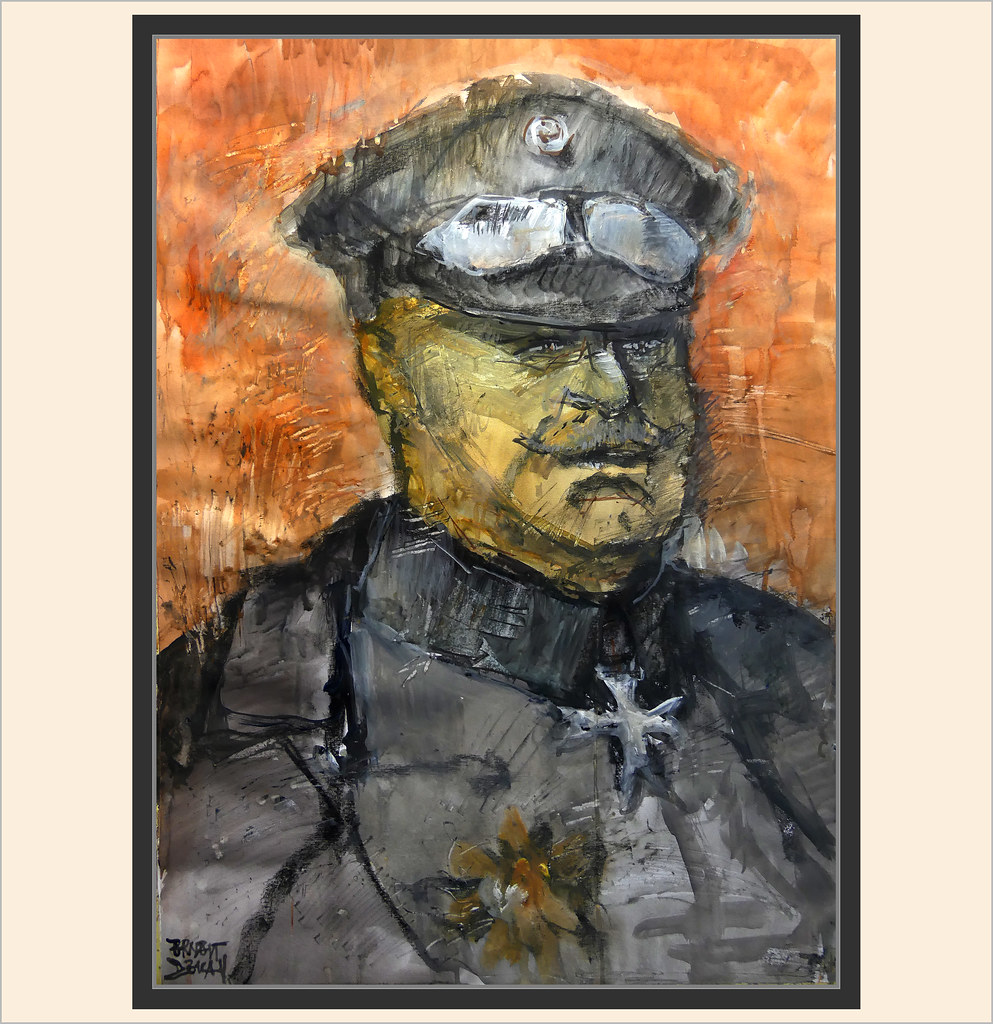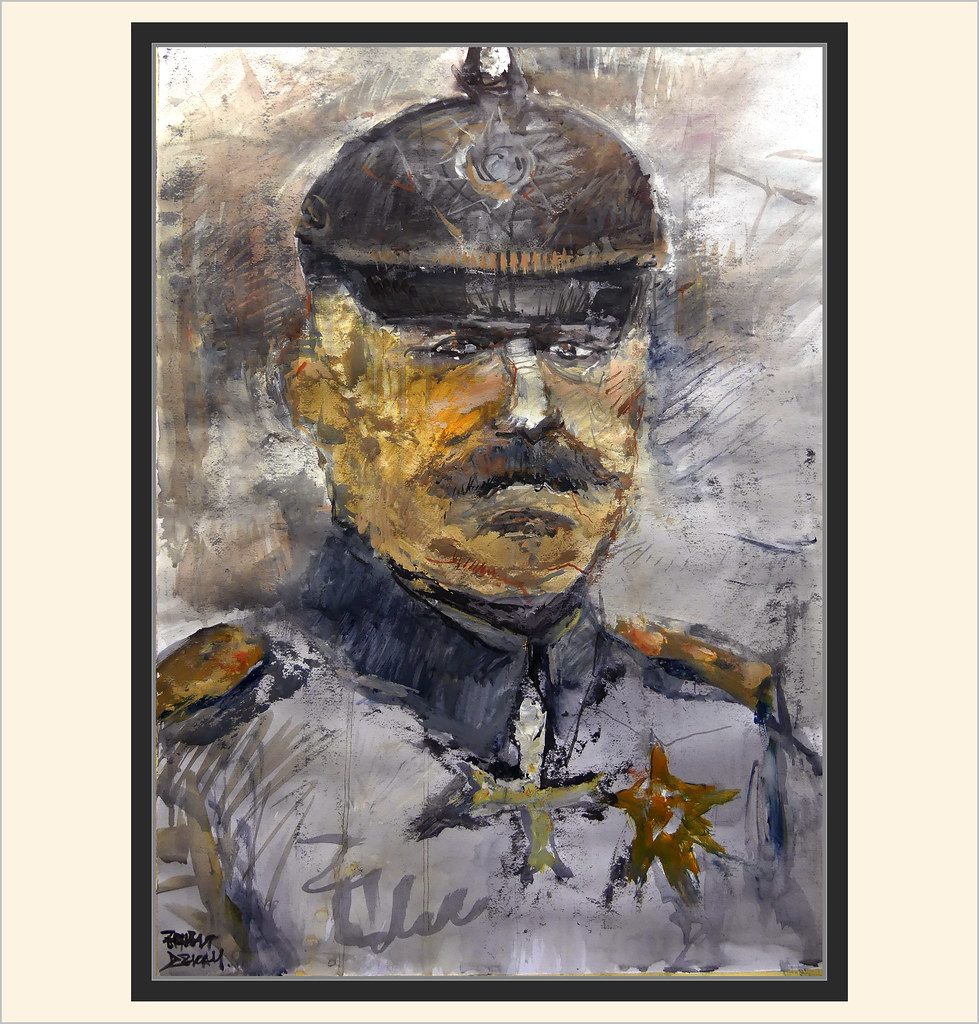#ERICH LUDENDORFF
Video
ERICH LUDENDORFF-PINTURA-ARTE-ALEMANIA-GENERAL-EJERCITO-PRIMERA GUERRA MUNDIAL-PERSONAJES-PRUSIA-HISTORIA-RETRATOS-ARTISTA-PINTOR-ERNEST DESCALS- por Ernest Descals
Por Flickr:
ERICH LUDENDORFF-PINTURA-ARTE-ALEMANIA-GENERAL-EJERCITO-PRIMERA GUERRA MUNDIAL-PERSONAJES-PRUSIA-HISTORIA-RETRATOS-ARTISTA-PINTOR-ERNEST DESCALS- Personajes representativos del militarismo prusiano en la historia del Reich de Alemania en la PRIMERA GUERRA MUNDIAL, retrato del general ERICH LUDENDORFF, uno los hombres de confianza del Kaiser Wilhelm II, vencedor de las batallas de Lieja en el frente occidental y de Tannenberg en el frente oriental. Uniformes y complementos del Ejército Imperial Alemán con expresiones humanas de mucho carácter. Pintura de retratos del artista pintor Ernest Descals sobre papel de 50 x 70 centímetros.
#PRIMERA GUERRA MUNDIAL#WW1#FIRST WORLD WAR#PERSONAJES HISTORICOS#HISTORIA#HISTORY#CHARACTERS#ERICH LUDENDORFF#PRUSIA#PRUSIANOS#ALEMANIA#GERMANY#REICH#KAISER#WILHEM II#GENERAL#GENERALES#EJERCITO ALEMAN#GERMAN ARMY#VICTORIAS#TANNENBERG#LIEJA#ART#ARTWORK#ARTE#PLASTICA#FINE ART#PAINTINGS#PAINTERS#PAINTER
0 notes
Text
Where did all the statues go?
Where did all the statues go?

View On WordPress
#Adolf Hitler#Bürgerbräukeller#Blutfahne#Der neunte Elf#Fahnenweihe#Feldherrnhalle#General Erich Ludendorff#Gustav von Kahr#Hermann Goring#Mahnmal der Bewegung#Mein Kampf#Munich#Nazi Germany#Nazism#Odeonsplatz#Rudolf Hess#World War 2
1 note
·
View note
Text
Heinrich Himmler's time line

This is Heinrich Himmler, the Head of the SS, timeline:
1900: He was born on 7th of October in Munich.
1905: His younger brother, Ernst Himmler, was born.
1913: he attended his father's school in Landshut, the town where the family had moved.
1919: From April 1919 Himmler joined various Freikorps, to "erase the shame of Versailles" and overthrow the "Marxist dictatorship". These enlistments were partly due to the guilt he had for not being able to fight in the Great War
1919: In August 1919 he was already working on a farm near Ingolstadt, but his work on the farm did not last long; On September 4 he fell ill. He had paratyphoid fever.
1919: On 18 October he was accepted as a student in agriculture at the University of Munich
1922: After completing his university studies in with a diploma in agriculture, he immediately found work at a fertilizer company, Stickstoff-Land
1923: He joined the Nazi Party in 1923, card N 156.
1923: He take part in the Failed Munich Putsch, but, while Ernst Röhm and Adolf Hitler were arrested, Himmler was considered an insignificant supporting actor and therefore did not suffer punishment.
1925: He was fired and, unemployed, decided to join Erich Ludendorff's new political formation, the National Socialist Liberation Movement.
1925: During that period he also met Gregor Strasser, of whom he soon became his personal secretary.
1925: An official of the Lower Bavarian Gau, based in Landshut, he took steps to revitalize the National Socialist sections in the area. He was promoted to vice-Gauleiter of Lower Bavaria-Upper Palatinate
1928: He married Margarete Boden
1929: He was appointed Reichsfuhrer SS by Hitler.
1929: His daughter, Gudrun Himmler, was born
1931: He commissioned Reinhard Heydrich to establish the SD.
1933: When the National Socialist Party took power in Bavaria on March 9, 1933, Himmler took control of the police.
1934: In May 1934, he had command of all police forces, with the exception of Prussia.
1934: He was one of the main organizers of the Night of the Long Knives
1934: As a reward for his role, Himmler gained control of the Gestapo, the secret political police.
1934: he gave the order to search the length and breadth of western Germany, until he found the ruins of the mountain fortress of Wewelsburg
1935: On December 10, 1935, "Lebensborn e.V." was founded in Berlin.
1936: Himmler was appointed Chef der Deutschen Polizei, or commander of the entire police, political and secret activity of the whole of Germany. In this new function, Himmler could participate in meetings of the Hitler government, since his position was equivalent to that of a minister.
1936: In the summer of 1936, he had the thousandth anniversary of the death of Henry I the Birdcatcher celebrated in Quedlinburg.
1936: Himmler issued a decree to proceed with the reorganization of the German police.
1937: At the end of the renovation works, Wewelsburg had transformed into a true shrine, with dozens of statues of Henry I the Birdcatcher, Frederick of Hohenstaufen and other German heroes.
1938: on 28 October 1938, Himmler had a note spread among all SS members, according to which it was a duty for every SS man to procreate at least four children to preserve his good blood before leaving for the front.
1939: The ''Operation Himmler'' begins the Second World War
1942: Reinhard Heydrich held the Wannsee Conference, where the so-called ''final solution'' was organized
1943: on October 4 and 6 he gave the Posen speeches.
1945: Himmler appeared for the last time at Hitler's Führerbunker in Berlin on 20 April 1945, on the occasion of the Führer's birthday
1945: A few days later, on April 23, Himmler met Count Folke Bernadotte, proposing German surrender on the Western Front but not on the Eastern Front; the Western Allies were careful not to take Himmler's peace proposal into consideration; however the offer made was spread through the press and, on 28 April, Radio London announced: "The Reichsführer of the SS claims that Hitler is dead and that he is his successor". In Berlin, a Hitler in the throes of an uncontrollable rage relieved him of all his political and military duties and ordered his arrest and shooting, orders which were not carried out due to the difficult stalemate in which they found themselves all departments of the army of the Third Reich.
1945: He killed himself on the 23 of May, 1945.
Sources:
Wikipedia: Heinrich Himmler
Heinrich Himmler: the sinister life of the Head of the SS by Heinrich Fraenkel and Roger Manvell
If you don't like it go with your life :))
Note: If I get new information from my research I will edit the post :))
I DON'T SUPPORT NAZISM, FASCISM OR ZIONISM IN ANY WAY THIS IS AN EDUCATIONAL POST
60 notes
·
View notes
Text
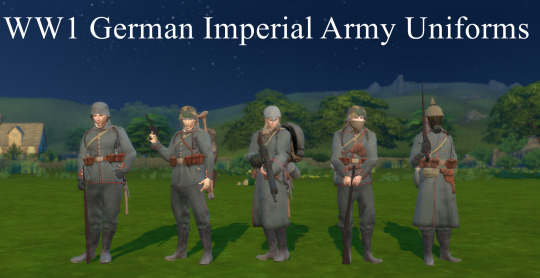
Hi Guys!! :D Long Time no see! I hope things are going well for everyone , Sorry for long ass Hiatus I had for all these times, I Got very Busy on Real Life stuff and Shits and I Even Barely Remember to continuing My Works here.. But Anyways show must go on. Thank you to @chere-indolante For Inspiration. Let's Just say it was Upgrade to Her Work With More Detailed Gear and More Variety of Helmet LOL.
DOWNLOAD
The Imperial German Army or Deutsches Heer was the name given to the combined land and air forces (excluding the Marine-Fliegerabteilung maritime aviation formations of the Navy) of the German Empire. It was formed after the unification of Germany under Prussian leadership in 1871 and dissolved in 1919, after the defeat of the German Empire in World War I.
Tech Specs
Coverted From "Battlefield 1" Game, Credits belongs to Electronic Arms
This Particular Uniform Belongs to German Imperial During Early Stages of war (1914-1916) since Later Uniform is more simplified.
1 Color Swatch fot all Uniform
HQ Compactible.
Male Only
UNIFORMS


Assault - Wearing tunics, scarfs and Stalhelms (the front of the helmet camouflaged by a brow plate). With smaller details such as leather pistol holster on his chest and ammo pouches around their stomach. As with all classes, one can identify which gun a certain class is using, with players holding SMGs having their weapons at their shoulders while shotguns are held at their waist.
Rifleman - Light Version of "Assault" Team, Wearing Exact configuration of said team. but only wearing A Rifle pouch. Most common sight in WWI German Front
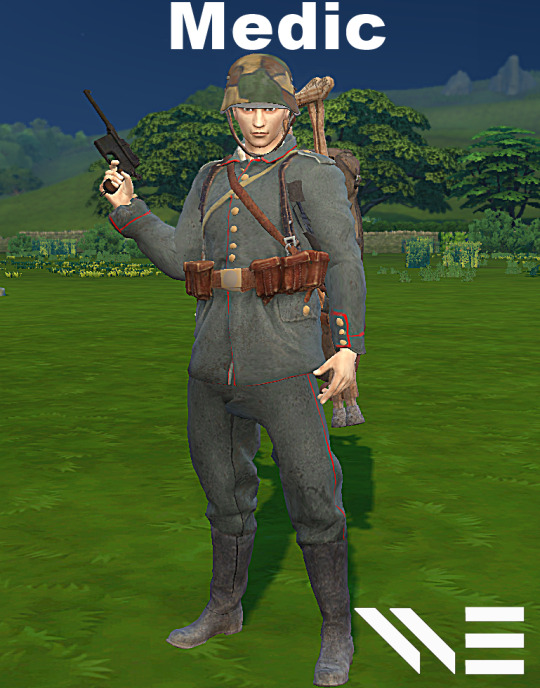
Medic - Wearing tunics, with crutches and backpacks on the back and grey Stalhelms. With smaller details being ammo pouches around their stomach and water canteen on the right side. Medics hold their rifles generally at their shoulders, while running they point them downwards.

Support - Wearing trench coats, with heavy backpacks on their back and the Gaede Helmet. With smaller details being ammo pouches around their stomach with additional pouches underneath them, water canteen on their right side. Supports hold their Machine guns around their waist.

Scout - Wearing a trench coat and a Stalhelm. With smaller details being ammo pouches around their stomach with additional pouches underneath their right side and a sidearm holster on their left side. Snipers hold their rifles at the shoulder when walking and point them downward while running, similar to the Medic.
HELMET

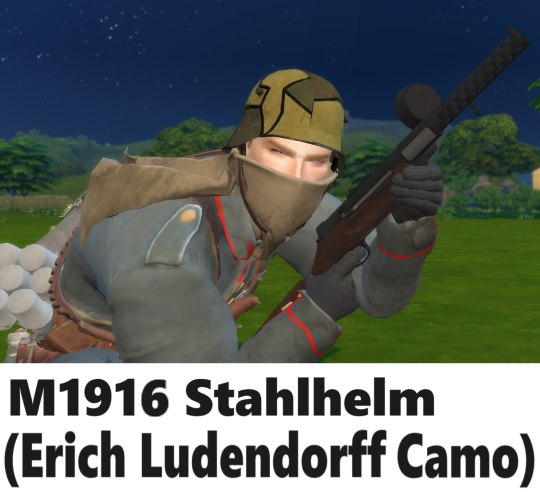
Stahlhelm M1916 - The Stahlhelm M1916 is an improved version of the German steel helmet introduced during World War I. Similar to the M1915, it features a distinctive design characterized by a rounded shape, a flared skirt, and a protruding visor. The M1916 model included enhancements to address issues with the earlier version, providing better protection to the wearer. It became a standard-issue helmet for German forces during World War I and continued to see use in various forms during subsequent conflicts. this is the Earliest version of Infamous German Stahlhelm that first fielded inside Imperial German Army. So don't Expect Better Protection like The Later model or WW2 Models. this also Include A German Tricolor Camouflage Designed by General Erich Ludendorff that Eventually Fielded in 1918.
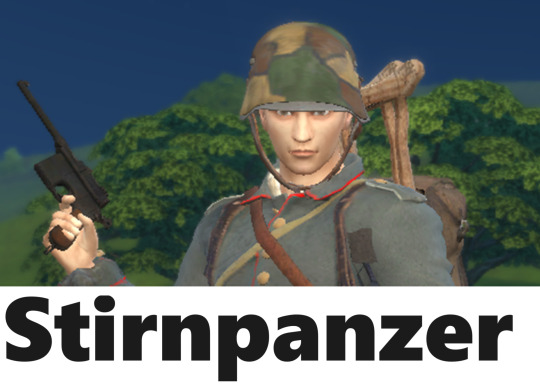
Stahlhelm Stirnpanzer - Due low Durability and Protection of M1916 Stahlhelm, German Ministry of War Issued Minor Upgrade. a The brow plate (Stirnpanzer), which was fitted to the front of the helmet to provide additional protection to the wearer. However, it's weight (2 kg) meant that it could only be worn for short periods. Approximately 50,000 brow plates were manufactured.
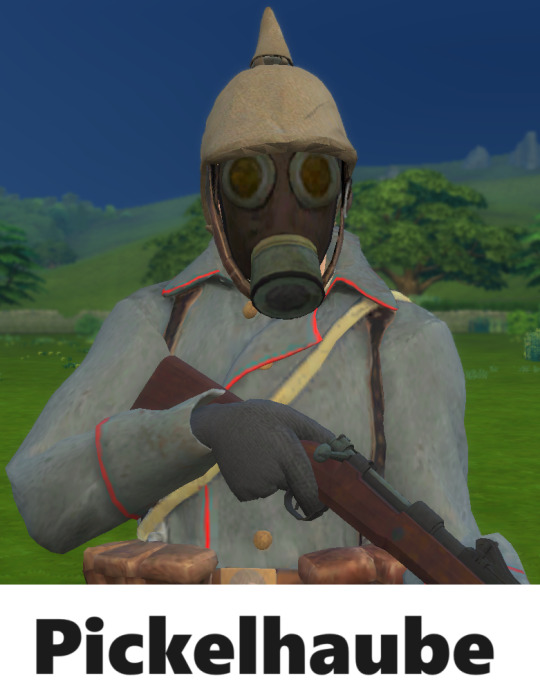
The Pickelhaube - The Iconic Helm From Prussian Era now Brought back to WWI Fronts. ickelhelm, is a spiked leather or metal helmet that was worn in the 19th and 20th centuries by Prussian and German soldiers of all ranks, firefighters and police. Although it is typically associated with the Prussian Army, which adopted it in 1842–43, the helmet was widely imitated by other armies during that period. It is still worn today as part of ceremonial wear in the militaries of certain countries, such as Sweden, Chile, and Colombia. This Particular Model is cloth helmet cover (Überzug) and For Cavalary use.
Gas Mask

During World War I, Chemical warfare was a significant and notorious aspect of World War I, and Germany played a key role in its early development. The Germans were the first to use chemical weapons on a large scale, introducing chlorine gas at the Second Battle of Ypres in 1915. This marked a disturbing escalation in warfare, as chemical agents were employed to harm and incapacitate enemy soldiers.
The use of chemical weapons by both sides, including mustard gas and phosgene, led to devastating consequences, causing widespread injuries and fatalities. The introduction of gas masks became essential for soldiers to protect themselves from these toxic substances. Despite the horrific nature of chemical warfare, it did not significantly alter the course of the conflict, and international agreements such as the Geneva Protocol of 1925 later sought to ban the use of chemical and biological weapons in warfare.
Gummimaske 1915 - The Gummimaske 1915, also known as the GM 15, was a German gas mask used during World War I. It featured a rubber face mask with glass eyepieces and a filter canister containing layers of absorbent materials to protect against chemical warfare agents. The design aimed to provide effective protection for soldiers against the poisonous gases used on the battlefield during the war. The Gummimaske 1915 was an essential piece of equipment for troops exposed to the threat of gas attacks during this period.
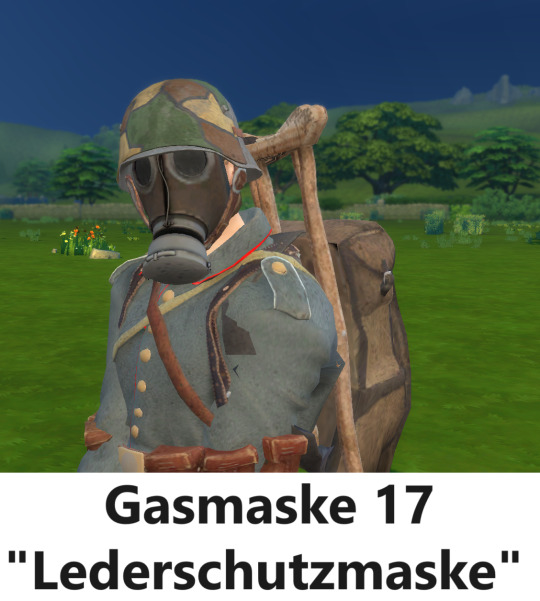
GM-17 Ledershutzmaske was introduced in 1917 to combat chemical weapons used by both sides in the First World War. It replaced the GM15 mask. It was another iteration of the German gas mask used during World War I. Similar to its predecessor, the GM 15, it featured a rubber face mask with glass eyepieces and a filter canister. The design aimed to provide reliable protection against chemical warfare agents that were employed during the war. The GM 17 continued the improvements made in gas mask technology, enhancing the comfort and effectiveness of the mask for soldiers on the battlefield. Like other gas masks of the time, it played a crucial role in safeguarding soldiers against the threats posed by poisonous gases during World War I.
#the sims 4#the sims#the sims 4 custom content#ts4#ts4 cc#ts4military#the sims 4 military#the sim#the sims 4 cc#ts4cc#ww1 germany#ww1#ww1 history#world war 1#world war one#first world war#ts4 wwi#WW1 Uniform#tw war#timeless#ts4 military
33 notes
·
View notes
Text
Getting into necromancy so I can call up Erich von Ludendorff's soul from whatever hell he's in and read Gundam Wing slashfic I find-and-replaced his and Luigi Cadorna's names into at him. Maybe extend it further to Gundam SEED slashfic and add Ferdinand Foch and Douglas Haig's names to the mix.

I take this as a dare, and I shan't be thought a coward.
16 notes
·
View notes
Text
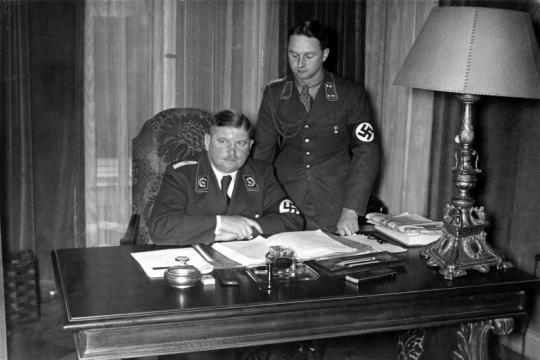
Röhm with his secretary and lover.

Röhm and the homosexual side of National Socialism
In my opinion, the only true National Socialist was Ernst Röhm. As head of the SA, he became increasingly competitive with Hitler. That and his refusal to see this "billigen Gefreiten" from Austria as "the Messiah" were the true reason why Hitler's henchmen murdered him. His sexual preference for other men was just a welcome reason for justification.
In fact, the German National Socialists were quite pragmatic and much more tolerant than the West portrays them today. As long as you didn't present your inclinations like a fag, but kept them private, it didn't matter. What the British did to their hero Alan Turing would never have happened in Germany. Even Jews were officially tolerated and simply declared “honorary Aryans” if they were worth it (Einstein was an impostor, which is why he had to flee).
The National Socialist Germans also allied themselves with Arabs as well as North Africans, and accepted them into the SS. So they were by no means racist towards other peoples; especially not Röhm, who often raved about Latino boys after his time as a military advisor in Bolivia.
Possible Alternative
However, in Röhm's opinion, the National Socialist movement was far from reaching its goal after 1933 and even lost its original profile under Hitler, increasingly neglecting many of its demands. He therefore called for a second German national movement. [Note: Erich Ludendorff also turned away from Hitler quite early on and saw him as a foreign agent with dubious origins.]
Röhm was an organizational genius and built the SA, a strong nationalist and originally very androphilic men's association that pursued its goals with brute force, the Reich's homophile thug gang, so to speak. Röhm could be a good historical role model for an androphile movement. I need to dig deeper into it and come to terms with my true roots. ;D
I imagine Röhm would have become Reichskanzler and Führer, and made the entire Reich increasingly more androphilic and homosexual through strict gender separation, reducing women to reproduction and household duties, while the boys and young men, well organized in the SA, completely stayed under themselves, just indulging in their masculinity and brotherhood all day long.
The cult of masculinity is always homoerotic
I have always found that there is something so fundamentally man-loving and homoerotic, even homosexual, about real National Socialism, in its original purity. The focus is clearly on men and the close brotherhood between them. Close physical and even sexual contact is just the last step if one were to consistently continue on this path of masculinity-worshipping cult.
In fact, there were also strong efforts in the Third Reich to dissolve the classic family image by means of so-called "Lebensborne", where men with optimal genetics simply impregnated women with desirable genetics and went on their way. The children then grew up together in the “Lebensborn”. There was therefore an effort to decouple sex and relationships with women.
8 notes
·
View notes
Text
History
January 27, 1943 - The U.S. 8th Air Force conducted the first all-American bombing raid on Germany as 55 bombers targeted Wilhelmshaven, losing three planes while claiming to have shot down 22 German fighters. The success of this first mission encouraged U.S. military planners to begin regular daylight bombing raids, which eventually resulted in high casualty rates for the American crewmen involved.
January 27, 1944 - Russian Army General Govorov announced the lifting of the Nazi blockade of Leningrad. During the 900-day siege, an estimated one million Russian civilians inside the city died of disease, starvation and relentless German shelling.
January 27, 1945 - The Russian Army liberated Auschwitz death camp near Krakow in Poland, where the Nazis had systematically murdered an estimated 2,000,000 persons, including 1,500,000 Jews.
January 27, 1967 - Three American astronauts were killed as a fire erupted inside Apollo 1 during a launch simulation test at Cape Kennedy, Florida.
January 27, 1973 - U.S. involvement in the Vietnam War ended as North Vietnamese and American representatives signed an agreement in Paris. The U.S. agreed to remove all remaining troops within 60 days thus ending the longest war in American history. Over 58,000 Americans had been killed, 300,000 wounded and 2,500 declared missing. A total of 566 prisoners-of-war had been held by the North Vietnamese during the war, with 55 reported deaths.
Birthday - Wolfgang Amadeus Mozart (1756-1791) was born in Salzburg, Austria. From the age of five, through his untimely death at age 35, this musical genius created over 600 compositions including 16 operas, 41 symphonies, 27 piano and five violin concerti, 25 string quartets, 19 masses, and many other works.
Birthday - British novelist Lewis Carroll (1832-1898) was born in Daresbury, Cheshire, England (as Charles Lutwidge Dodgson). Best known for Alice's Adventures in Wonderland and Through the Looking Glass. He also lectured in mathematics and was a pioneering photographer.
Birthday - Labor leader Samuel Gompers (1850-1924) was born in London. He emigrated to America at age 13, worked in a cigar factory, eventually becoming head of the Cigar Workers' Union. He later brought together several national unions under the name American Federation of Labor and became its first president.
Birthday - German Kaiser Wilhelm II (1859-1941) was born. He was a grandson of England's Queen Victoria and ruled Germany from 1888 through World War I. Although he had military training, he left conduct of the war mainly in the hands of Generals Paul von Hindenburg and Erich von Ludendorff. In 1918, amid the defeat of Germany, he abdicated and fled to the Netherlands where he lived in seclusion until his death. He was given a military funeral by Hitler
2 notes
·
View notes
Text
The Battle of Tannenberg Ended With the Destruction of the Russian Second Army, With 140,000 Killed, Injured, or Captured by the German 8th Army. August 30, 1914.
Image: Russian prisoners of war after the Battle of Tannenberg (Wikimedia Commons.)
On this day in history, August 30, 1914, the Battle of Tannenberg ended with the destruction of the Russian Second Army, with 140,000 killed, injured, or captured by the German 8th Army led by Paul von Hindenburg and Erich Ludendorff.
History Daily: 365 Fascinating Happenings Volume 1 & Volume 2 – August 30,…

View On WordPress
4 notes
·
View notes
Text
Also, case i've got anyone's attention: it occurs to me that one of the arguably biggest failings of warhammer 40k/modern 40k especially is that it fails to comment or do anything meaningful with the concept of the 'total war'.
to tl:dr a bit here, the concept of the total war extends beyond just the military sense and is in fact more complicated then just the idea of 'what if we bombed civilian infrastructure?' in a war that youve probably heard of.
In short the coinage of the phrase comes from Erich Ludendorff, one of the primary generals of the german empire in WW1 who was moderately more successful then a lot of the other generals in WW1, but also helped instigate the 'soft military dictatorship' germany had going on for the later half of WW1, was a major asshole, and an out and out nazi after the war who helped popularize some of the more common nazi beliefs and in general aid their rise to power.
anyways, Ludendorff wrote a book before he died, called der totale krieg [the total war] which ended up being rather popular [and arguably more influential then mein kampf] with groups like the nazis or imperial japan. and the essential argument of der totale krieg is that 'humanity exists in a state of perpetual war, with peace only being the pauses between wars. therefore a strong society is one perpetually in a state of mobilization physically and morally'.
which brings us back to warhammer 40k, because on paper the imperium of man is a perfect case example of what a society perpetually in a state of mobilization looks like. every facet of the imperium is mobilized for war at any given point, its infrastructure is dedicated almost entirely to the production of and shipment of weapons and manpower, the values of war and constant vigilance in the 'eternal war' are stressed on a moral and spiritual level, the imperium on paper is the totale krieg society ludendorff alludes to [though obviously in not the same positive light or manner as ludendorff likely envisioned].
but as i mentioned, I dont think 40k ever really handles it in as deep a manner as it could, instead treating those elements that make up the 'totale krieg' more as set dressing then as something to seriously grapple and contend with. No more evident I feel then in how most thematic threads of the 40k setting tend to be tied into ideas on religion and spirituality [and notably in an often rather 'populist' mode of thought on how those things interact with and shape society and culture] well possible threads on the totale krieg tend to be more so incidental then considered.
7 notes
·
View notes
Text
Notas de Una debilidad por explotar
Recomiendo, encarecidamente, que estas notas se lean después de haber terminado el capítulo 6. Contienen spoilers que arruinan completamente la experiencia y el esfuerzo puesto en desarrollar la historia.
Sin más dilación, aquí las dejo. Es larguito.
1. El problema de Guinea Ecuatorial.
A pesar de que Alemania quería evitar que el conflicto se trasladase a África, puesto que no tenía los medios para defender las colonias, no pudo hacer nada.
El 15 de febrero de 1916, mil alemanes y cuarenta y seis mil cameruneses (hay fuentes que dicen que fueron más de cincuenta mil en total) cruzaron la frontera entre Camerún y Guinea Ecuatorial. Las fuerzas franco-británicas habían rodeado Camerún con el ánimo de invadirla, y la población civil, sumada a los soldados en dicho territorio, entraron en Guinea con el fin de solicitar asilo a las autoridades españolas.
Fue una situación delicada por los militares que habían cruzado; los aliados protestaron ante la posibilidad de que se pudiese estar preparando un contraataque desde Guinea (a pesar de que, a la hora de cruzar la frontera, los soldados se habían rendido y entregado sus armas de manera pacífica). A su vez, se temía una invasión de Guinea a manos de la Entente.
Las autoridades españolas (aproximadamente un centenar de personas), que solo habían intentado alimentar, mantener y proteger a los miles de huidos de la guerra, cumplieron las exigencias de la Entente, y trasladaron al contingente alemán a la isla de Fernando Poo, a la ciudad de Santa Isabel, junto a sus soldados africanos. Se permitió entonces que los oficiales franceses e ingleses organizasen la colonia —como se informaría en el periódico francés Le Journal.
(Se llegaron a establecer hospitales, aunque las condiciones higiénicas y alimentarias evitaron que todos pudieran salvarse.)
Aun con eso, los mandos de la Entente siguieron presionando, hasta el punto de que el Gobierno español trasladaría a la Península a los soldados.
La polémica seguiría cuando, al ser llevados a Alcalá de Henares, Pamplona y Zaragoza, las poblaciones los recibirían de una manera tan afectuosa que, según los periódicos de la época, parecía más bien «el recibimiento de un país aliado de Alemania que el de uno neutral».
Aunque, por suerte, no llegó a más.
Como curiosidad; algunos de los alemanes huirían por la poca vigilancia y las suaves medidas, otros se casarían con españolas y una pequeña proporción de ellos volvería a Alemania.
.
2. Línea Hindenburg.
Fue planificada por Paul von Hindenburg y Erich Ludendorff, que forzaron la vuelta a la política submarina sin restricciones [de la que ya hablaré más adelante] para poner la atención de los aliados en otro sitio.
Se empezó a finales de 1916 con el fin de recuperar sus fuerzas —que se habían resentido gracias a las Batallas de Verdún y del Somme—, y retirarse a trincheras con mejores fortificaciones.
Fue construida de octubre de 1916 a marzo de 1917, periodo en el que se añadieron unos ocho trenes al día al tráfico normal, aunque la retirada no empezaría hasta febrero de 1917.
Los aliados la descubrieron en octubre de 1916, y la rastrearon hasta el 15 de abril de 1917, día en el que los aviones que revisaban el progreso fueron derribados.
(Al principio, desde la Entente, se la denominó línea Drocourt-Quéant).
Esta defensa no caería hasta el septiembre de 1918, a dos meses de terminar la guerra.
.
3. Convenciones de La Haya.
Dejaré que los juzguéis por vosotros mismos con lo que ya habéis leído.
Artículo 4. Los prisioneros de guerra están en poder del Gobierno enemigo, pero no en el de los individuos o en el de los Cuerpos que los hayan capturados.
Deben ser tratados con humanidad.
Todo lo que les pertenezca personalmente, excepto las armas, los caballos y los papeles militares, queda de su propiedad.
Artículo 6. El Estado puede emplear, como trabajadores, a los prisioneros de guerra, según su grado y aptitudes. Dichos trabajos no serán excesivos y no tendrán ninguna relación con las operaciones de la guerra [añado la información de que aquellos a los que utilizaban para construir la Línea Hindenburg eran, en su mayoría, presos rusos].
Los trabajos hechos para el Estado serán pagados con arreglo a las tarifas vigentes para los militares del Ejército nacional que ejecuten iguales trabajos. Cuando los trabajos tengan lugar por cuenta de otras Administraciones públicas o de particulares, sus condiciones se fijarán de acuerdo con la Autoridad militar.
Los haberes de los prisioneros contribuirán a aliviar su situación y el exceso les será entregado al ser libertados, descontándoles los gastos de manutención.
Artículo 7. El Gobierno en cuyo poder se encuentren los prisioneros de guerra estará encargado de su mantenimiento.
A falta de acuerdo especial entre los beligerantes, los prisioneros de guerra serán tratados, en cuanto a la manutención, alojamiento y vestuario, bajo el mismo pie que las tropas del Gobierno que las hayan mantenido.
(Y un bonus para los intentos de escape.)
Artículo 8. Los prisioneros de guerra estarán sometidos a las leyes, reglamentos y órdenes vigentes en el Ejército del Estado en cuyo poder se encuentren.
Cualquier acto de insubordinación autoriza, respecto a ellos, las medidas de rigor necesarias. Los prisioneros evadidos que sean cogidos de nuevo antes de haberse podido unir a su Ejército, o antes de abandonar el territorio ocupado por el Ejército que los hubiera capturado, estarán sujetos a las penas disciplinarias.
Los prisioneros que, después de haber logrado evadirse, sean hechos prisioneros nuevamente, no estarán sujetos a ninguna pena disciplinaria por la fuga anterior.
.
4. Fuerte MacDonald.
Actualmente llamado Fuerte de Mons-en-Baroeul —ya os podéis imaginar lo gracioso que fue buscarlo de primeras sin saberlo—, esta prisión, ahora reconvertida en restaurante, estaba ubicada en Lille, Francia.
(Lo digo porque, en la página de prisioneros australianos de la que saqué la información, ubicaban erróneamente el Fuerte en la Lille belga. Por eso tanta referencia a la confusión a lo largo de la historia).

[Esta era la entrada principal; el patio interior de ladrillo rojo que atraviesan.]

[Este es el pasadizo que atraviesan hasta llegar al interior.]
La información que se conoce del lugar es gracias a los testimonios de los supervivientes, a partir de 1917. No se sabe en qué momento empezó la malnutrición, puesto que las causas por las que se dice que los alimentos no pudieron llegar, es decir, el bloqueo submarino británico a las zonas invadidas, había estado desde el principio de la guerra.
Además, se sabe que los guardias de los campos de prisioneros recurrían a la desnutrición e incluso a la tortura psicológica, por lo que... quién sabe.
Dado que creo que el capítulo se encarga bastante bien de explicarlo, y que en el siguiente se añaden otros ciertos detalles, solo voy a mencionar un detalle: había una mortalidad de 1 sobre 12, y si fue tan «baja» fue gracias a las provisiones que les mandaba la Cruz Roja.
Si queréis saber más, aquí tenéis el link de la página de donde saqué la mayoría de detalles. (Tened en cuenta el detalle de que es la Lille francesa, no la belga).
#en la cuarta planta de palacio#capítulo 6#notas#aph spain#hws spain#hws germany#hws australia#qué poco me queda por explicar ya de la historia#solo dos capítulos#madre mía#quién me lo hubiese dicho a mí hace dos meses
2 notes
·
View notes
Video
ERICH LUDENDORFF-ARTE-PINTURA-RETRATOS-GENERAL-EJERCITO-ALEMANIA-PERSONAJES-MILITARES-PRIMERA GUERRA MUNDIAL-PINTOR-ERNEST DESCALS por Ernest Descals
Por Flickr:
ERICH LUDENDORFF-ARTE-PINTURA-RETRATOS-GENERAL-EJERCITO-ALEMANIA-PERSONAJES-MILITARES-PRIMERA GUERRA MUNDIAL-PINTOR-ERNEST DESCALS- El gran general ERICH LUDENDORFF del ejército de Alemania en la Primera Guerra Mundial, figura militar que se hizo célebre en la victoria de Tannenberg que logró la victoria ante los soldados del Imperio Ruso, mas tarde estuvo involucrado en el Putsch de Múnich junto al líder nacionalsocialista Adolf . Pintura de retratos de los personajes militares y políticos alemanes, cuadro del artista pintor Ernest Descals sobre papel de 50x 70 centímetros.
#ALEMANIA#GERMANY#CHARACTERS#HISTORIA#HISTORY#PERSONAJES#EJERCITO#GERMAN ARMY#PRIMERA GUERRA MUNDIAL#ERICH LUDENDORFF#II REICH#MILITARY#MILITARES#GENERAL#PUTSCH#MUNICH#ADOLF HITLER#PORTRAIT#RETRATO#RETRATOS#RETRATAR#PINTAR#PINTANDO#FIGURAS#PRUSIA#PRUSIANOS#WW1#PLASTICA#FINE ART#PAINTING
0 notes
Text
UPDATE 43 – THE EMPIRE HAS FALLEN

May 10 1917
News has arrived revealing the fall of the German Empire. Kaiser Wilhem II has been removed from power in a revolution by troops who have stormed the Hohenzollern Palace. The German Empire is now under a military junta led by a triumvirate consisting of General Erich Ludendorff, Admiral Eduard Von Capelle, and Foreign Minister Arthur Zimmermann.
0 notes
Text
If Wonder Woman kills Erich Ludendorff in Wonder Woman (2017), who creates the Weimar Republic with Paul Von Hindenburg?
Who gives the evil man legitimacy during the Munich Putch?
Is WW2 not cannon in the DCEU?
0 notes
Text
The Beer Hall Putsch, also known as the Munich Putsch,[1][note 1] was a failed coup d'état by Nazi Party (Nationalsozialistische Deutsche Arbeiterpartei or NSDAP) leader Adolf Hitler, Generalquartiermeister Erich Ludendorff and other Kampfbund leaders in Munich, Bavaria, on 8–9 November 1923, during the Weimar Republic. Approximately two thousand Nazis marched on the Feldherrnhalle, in the city centre, but were confronted by a police cordon, which resulted in the deaths of 16 Nazis, four police officers, and one bystander.[2][3]
Hitler escaped immediate arrest and was spirited off to safety in the countryside. After two days, he was arrested and charged with treason.[4]
The putsch brought Hitler to the attention of the German nation for the first time and generated front-page headlines in newspapers around the world. His arrest was followed by a 24-day trial, which was widely publicised and gave him a platform to express his nationalist sentiments to the nation. Hitler was found guilty of treason and sentenced to five years in Landsberg Prison,[note 2] where he dictated Mein Kampf to fellow prisoners Emil Maurice and Rudolf Hess. On 20 December 1924, having served only nine months, Hitler was released.[5][6] Once released, Hitler redirected his focus towards obtaining power through legal means rather than by revolution or force, and accordingly changed his tactics, further developing Nazi propaganda.[7]
0 notes
Text
On this day in Wikipedia: Wednesday, 8th November
Welcome, Willkommen, Benvenuto, नमस्ते 🤗
What does @Wikipedia say about 8th November through the years 🏛️📜🗓️?

8th November 2020 🗓️ : Event - Second Nagorno-Karabakh War
Second Nagorno-Karabakh War: Azerbaijani forces defeated the self-proclaimed Republic of Artsakh in the Battle of Shusha, reclaiming the town after 28 years.
"The Second Nagorno-Karabakh War was an armed conflict in 2020 that took place in the disputed region of Nagorno-Karabakh and the surrounding occupied territories. It was a major escalation of an unresolved conflict over the region, involving Azerbaijan, Armenia and the self-declared Armenian..."
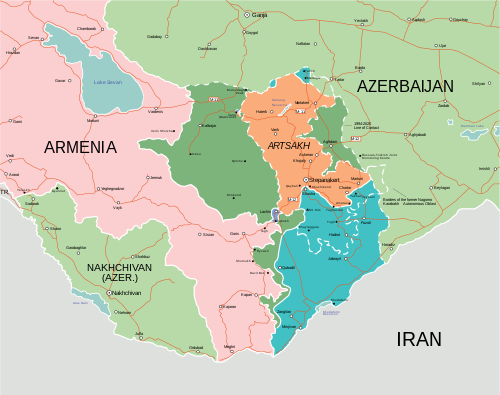
Image licensed under CC BY-SA 3.0? by Kalj, based of File:2020 Nagorno-Karabakh war map.png by User:Golden
8th November 2016 🗓️ : Event - 2016 Indian banknote demonetisation
Indian Prime Minister Narendra Modi publicly announces the withdrawal of ₹500 and ₹1000 denomination banknotes.
"On 8 November 2016, the Government of India announced the demonetisation of all ₹500 and ₹1,000 banknotes of the Mahatma Gandhi Series. It also announced the issuance of new ₹500 and ₹2,000 banknotes in exchange for the demonetised banknotes. Prime Minister Narendra Modi claimed that the action..."

Image licensed under CC BY 3.0? by Biswarup Ganguly
8th November 2013 🗓️ : Event - Typhoon Haiyan
Typhoon Haiyan, one of the strongest tropical cyclones ever recorded, strikes the Visayas region of the Philippines; the storm left at least 6,340 people dead with over 1,000 still missing, and caused $2.86 billion (2013 USD) in damage.
"Typhoon Haiyan, known in the Philippines as Super Typhoon Yolanda, was one of the most powerful tropical cyclones ever recorded. On making landfall, Haiyan devastated portions of Southeast Asia, particularly the Philippines. It is one of the deadliest Philippine typhoons on record, killing at least..."
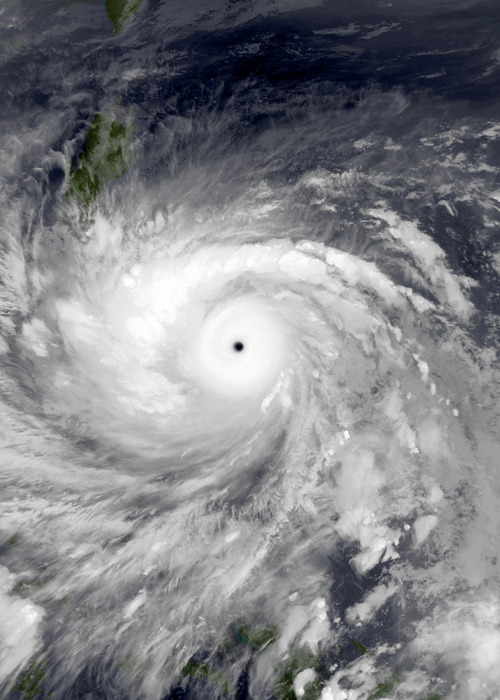
Image by NASA, LAADS Web, HDF File processed by Supportstorm
8th November 1973 🗓️ : Event - John Paul Getty III
The right ear of John Paul Getty III is delivered to a newspaper outlet along with a ransom note, convincing his father to pay US$2.9 million.
"John Paul Getty III (; born Eugene Paul Getty II; November 4, 1956 – February 5, 2011) was the grandson of American oil tycoon J. Paul Getty, who was once the richest man in the world. While living in Rome in 1973, he was kidnapped by the 'Ndrangheta and held for a $17 million ransom. His..."
8th November 1923 🗓️ : Event - Beer Hall Putsch
Beer Hall Putsch: In Munich, Adolf Hitler leads the Nazis in an unsuccessful attempt to overthrow the German government.
"The Beer Hall Putsch, also known as the Munich Putsch, was a failed coup d'état by Nazi Party (Nationalsozialistische Deutsche Arbeiterpartei or NSDAP) leader Adolf Hitler, Generalquartiermeister Erich Ludendorff and other Kampfbund leaders in Munich, Bavaria, on 8–9 November 1923, during the Weimar..."
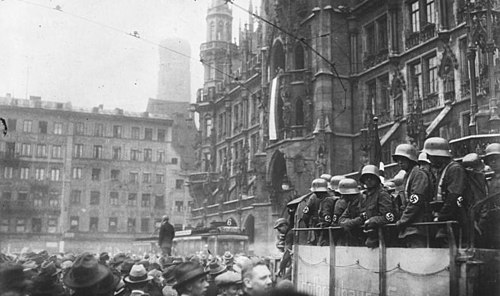
Image licensed under CC BY-SA 3.0 de? by
UnknownUnknown
8th November 1817 🗓️ : Death - Andrea Appiani
Andrea Appiani, Italian painter and educator (b. 1754)
"Andrea Appiani (31 May 1754 – 8 November 1817) was an Italian neoclassical painter...."
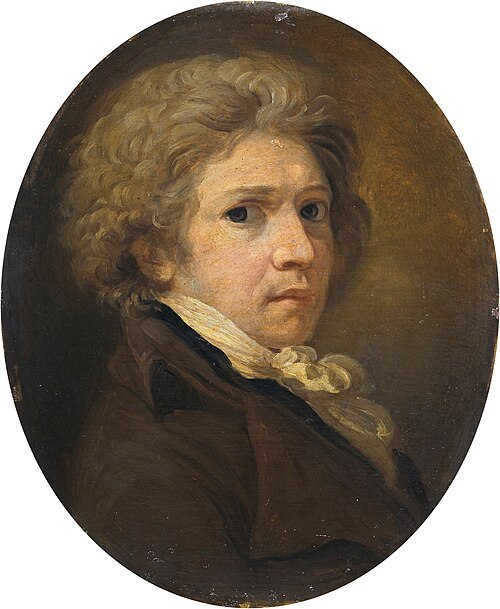
Image by Andrea Appiani
8th November 🗓️ : Holiday - International Day of Radiology (European Society of Radiology)
"The International Day of Radiology (IDoR) is an annual event promoting the role of medical imaging in modern healthcare. It is celebrated on November 8 each year and coincides with the anniversary of the discovery of x-rays. It was first introduced in 2012, as a joint initiative of the European..."
0 notes
Text
The Socially Engineered Society
Our entire society is planned from start to finish, modeled step by step with targeted operations that an elite passes on from top to bottom.
We live in a neo-feudalistic system where a super-rich global caste exerts influence over the masses through a vast layer of authorities and lackeys.
Their power can only be broken through enlightenment, just as Erich Ludendorff, the great German general, once demanded in 1927: Vernichtung der Freimaurerei durch Enthüllung ihrer Geheimnisse [Destruction of Freemasonry by revealing its secrets].
Nothing is more damaging to their power than revealing the facts, the truth by clearly naming things. Therefore, on these days, people who say things bluntly are considered uncomfortable and unpopular.
They constantly spread false information through the secret services they control, create or infiltrate movements of any kind, and even invent a new politically correct language in all Western nations to manipulate people's minds by building up supposed sensitivities.
Same things happen everywhere, regardless of national borders.
History is scripted like a film
Erich Ludendorff soon turned away from Adolf Hitler when he recognized him as a foreign British agent who was specifically trained and supported by the lodges in order to plunge the German Reich into ruin. Why else did Hitler deliberately allow nearly 400,000 Allied soldiers to escape at Dunkirk, whose capture would have rendered Britain unable for continuing the war? Why else did Hitler let the Wehrmacht withdraw to the Caucus when they were already close to Moscow and able to take the city, especially since the fall of Moscow would also have meant the fall of Stalin?!
They don't want any nation to win, they just want to cause damage in order to build their world state from the rubble. At that time, the parasites rejected the British Empire in favor of the USA as their new host body, as their new tool for the realization of the desired world state. If it had been Germany, they would have let Germany win World War II. But instead they let the USA equipped its worst class enemy, the Bolsheviks under Stalin, financially, materially and with weapons so that the German Reich could be defeated by Central Asian backwoodsmen.
They spread such seeds of destruction into many nations in order to cause damage. The best current example is Zelenskyy, who until a few years ago was not even Ukrainian, but deliberately built up as an actor to lead an entire country into a completely pointless win-or-scorch-earth war, just as Hitler did. To ensure the disguise was perfect, they chose a Jew. The only difference is that Ukraine is nothing compared to Germany and Zelenskyy is masked as a democratic shining light in today's zeitgeist. But if you look behind the headlights, you can see many interesting parallels.
15 notes
·
View notes
